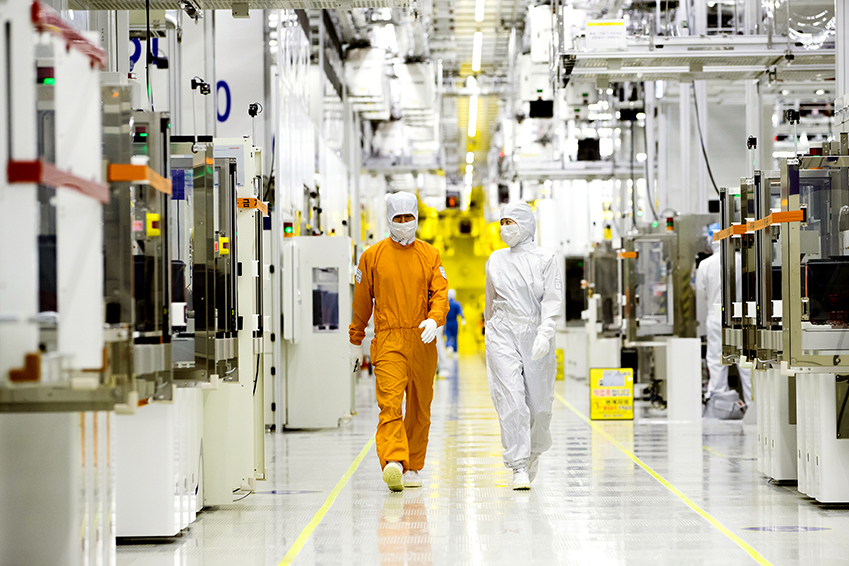[News Focus] Korean chipmakers expect to bottom out in H2
Memory chip prices steady now signaling demand recovery, but Japan export curbs remain a risk factor
By Song Su-hyunPublished : Sept. 22, 2019 - 16:06
The semiconductor firms in South Korea are holding their breath at the current market conditions, hoping they have avoided the worst.
“Starting with NAND, memory chip prices are showing signs of a rebound,” said an industry insider. “DRAM prices also stopped falling last month, which we hope is a sign of bottoming out finally.”
“Starting with NAND, memory chip prices are showing signs of a rebound,” said an industry insider. “DRAM prices also stopped falling last month, which we hope is a sign of bottoming out finally.”

The price of three-dimensional high-spec NAND rose for two months in a row, while the most widely used memory DRAMs halted their price fall in August for the first time since September 2018.
“The price rebounds are interpreted as a sign of recovery in demand,” the official said.
At least until the end of July, forecasts of the country’s most lucrative industry that supports the economy were dire.
Driven by delayed orders from major customers, Samsung Electronics and SK hynix saw their inventory levels rising.
On top of that, memory prices have been declining since 2016, which dealt a severe blow to the first- and second-quarter profits of the chipmakers.
And to make the matters worse, Japan slapped restrictive measures on exports of three materials for Korea’s semiconductor and display industry starting on July 4.
“It’s fortunate that there are no additional restrictions on other materials since then,” said a Samsung official. “Two export contracts for photoresists and one for etching gas were approved by the Japanese customs authority so far, though like sprouts in a drought.”
Such positivity is being reflected in the share price of Samsung and SK hynix.
After hitting a three-month low of 42,500 won on Aug. 6, the Samsung shares have been rising, reaching 49,600 won on Friday.
SK hynix shares were volatile over the past three months from the lowest point of 65,500 won on June 24 to the highest of 84,600 won on Sept. 9.
Despite the adverse export conditions, Samsung is expected to claim a 47 percent share of the global DRAM market in the third quarter, the largest in three years, according to data by IHS Markit.
“The increased share could be translated to an improvement in the third-quarter earnings,” said a Samsung official. “And it also shows that customers do recognize the quality of Samsung memory products.”
Meanwhile, SK hynix remains relatively cautious about the second-half earnings.
The company’s DRAM market share is predicted to fall from 30 percent in the thirst quarter to 27 percent in the third quarter.
As it has announced, the chipmaker with over 90 percent of its earnings coming from DRAM chips, is planning curtail its production from the fourth quarter.
“The industry seems to have become steady, and we are hearing some positive news,” said an SK hynix official. “But to confirm the price rebound and demand recovery, we will have to wait until the beginning of the next quarter.”
Unlike Samsung, no export contracts have been approved by Japan for chip materials.
By Song Su-hyun (song@heraldcorp.com)







![[KH Explains] Hyundai's full hybrid edge to pay off amid slow transition to pure EVs](http://res.heraldm.com/phpwas/restmb_idxmake.php?idx=644&simg=/content/image/2024/04/18/20240418050645_0.jpg&u=20240419100350)






![[From the Scene] Monks, Buddhists hail return of remains of Buddhas](http://res.heraldm.com/phpwas/restmb_idxmake.php?idx=652&simg=/content/image/2024/04/19/20240419050617_0.jpg&u=20240419175937)

![[KH Explains] Hyundai's full hybrid edge to pay off amid slow transition to pure EVs](http://res.heraldm.com/phpwas/restmb_idxmake.php?idx=652&simg=/content/image/2024/04/18/20240418050645_0.jpg&u=20240419100350)

![[Today’s K-pop] Illit drops debut single remix](http://res.heraldm.com/phpwas/restmb_idxmake.php?idx=642&simg=/content/image/2024/04/19/20240419050612_0.jpg&u=)